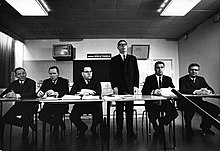Communist Party of Finland
You can help expand this article with text translated from the corresponding article in Finnish. (June 2023) Click [show] for important translation instructions.
|
Communist Party of Finland Suomen Kommunistinen Puolue | |
|---|---|
 | |
| Abbreviation | SKP |
| Founded | 29 August 1918 |
| Legalized | 1944 |
| Dissolved | 1992 |
| Split from | Social Democratic Party of Finland |
| Succeeded by | |
Comintern | |
| Colors | Red |
| Part of a series on |
| Communist parties |
|---|
The Communist Party of Finland (
The SKP was banned by the state from its founding
History

Early stages
In 1918, the
The SKP was illegal in Finland until 1944, and members could be imprisoned. After the Continuation War, the SKP dominated the Finnish People's Democratic League, which was founded in 1944 as an umbrella organization of the radical left.
Cold War


The
The SKP received substantial financial support from the
Aftermaths of the Prague Spring
The events of the
In 1985–1986 a large number of Taistoists, hundreds of party organizations with thousands of members, were expelled. They regrouped as the Communist Party of Finland (Unity) (SKPy) which later evolved into the current Communist Party of Finland (1994).
Collapse
The dissolution of the Soviet Union in the early 1990s led to ideological conflicts: bitter internal disputes plagued the party. Bad stock-market investments made during Aalto's term of office resulted in financial bankruptcy in 1992. The SKP never recovered. A majority of the party members, with other member-organizations of SKDL, formed the Left Alliance in 1990.
SKPy, originally the faction of the party expelled in 1985–1986, outlasted its parent and registered itself as the Communist Party of Finland in 1997, but has failed to regain the former Communist Party's parliamentary representation. In the elections of 2007 it won 0.7% of the vote; in April 2011, it won just 0.3%.[6]
Youth wing
The youth wing of the SKP was the
Leaders
Chairmen
|
General secretaries
|
See also
- Kaisu-Mirjami Rydberg
- List of Communist Party (Finland) breakaway parties
- List of Social Democratic Party (Finland) breakaway parties
References
- ISBN 951-9455-55-8.
- ^ Benjamin, Roger W.; Kautsky, John H. Communism and Economic Development, in the American Political Science Review, vol. 62, no. 1. (Mar. 1968), pp. 122.
- ISBN 951-1-14497-9.
- ^ Tuomioja, Erkki (2008). "The Effects of the Prague Spring in Europe". Retrieved 2 January 2015.
- ISBN 0-275-96372-1.
- ^ 9.232 of 2.939.571 (Ministry of Justice Finland Archived 20 April 2011 at the Wayback Machine)
- ^ a b Krekola, Joni (2006). Stalinismin lyhyt kurssi (in Finnish). SKS. p. 108.
